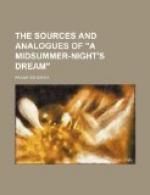Shakespeare’s apparent confusion of a May-day with a Mid-summer-night may seem pardonable to the folk-lorist in the light of the fact that various folk-festivals appear to take place indiscriminately on May-day or Midsummer-day. See Chambers, op. cit. i. 114, 118, 126.
[18] Cf. III. ii. 331 and 401, etc.
[19] Cf. IV. i. 100-183.
[20] In V. i. 51.
[21] Reprinted in this book, p. 135.
[22] He might have added Lucius the Ass, a similar tale by Lucian of Samosata.
[23] Reprinted in this book, p. 139.
[24] Ovid, Met. iv. 55, sqq.
[25] See p. 73.
[26] Addl. MS. 15227, f. 56b.
[27] Faerie Queen, II. i. 6, II. x. 75.
[28] See A.W. Ward’s English Dramatic Literature, i. 400, ii. 85.
[29] The Marchantes Tale, 983 (Skeat, E. 2227).
[30] A.H. Bullen’s edition of Campion (1903), p. 20.
[31] Metamorphoses, iii. 173. Ovid, in the same work, uses “Titania” also as an epithet of Latona (vi. 346), Pyrrha (i. 395), and Circe (xiv. 382, 438). The fact that Golding gives “Phebe” as the translation of “Titania” in iii. 173, is a strong piece of evidence that Shakespeare sometimes at least read his Ovid in the Latin.
[32] Ed. Brinsley Nicholson, p. 32. Book III, chap. ii. (See p. 135.)
[33] Romeo and Juliet, I. iv, 53, sqq.
[34] In II. i. 40, “sweet puck” is no more a proper name than “Hobgoblin”; so also in l. 148 of the same scene. In neither case should the name be printed with a capital P.
[35] II. i. 34.
[36] V. i. 418, 421.
[37] Wright, English Dialect Dictionary, s.v. Puck, gives Scotland, Ireland, Derby, Worcester, Shropshire, Gloucester, Sussex and Hampshire as localities where the name is recorded.
[38] Text H in Child’s Ballads, I. 352.
[39] Campbell’s Popular Tales of the West Highlands (1890), vol. ii, tales xxv, xxvi, etc.
[40] Ballads, I. 314, and note.
[41] M.N.D., II. i. 40. (See note on p. 37.)
[42] The Wyf of Bathe’s Tale, at the beginning; and elsewhere.
[43] The Faerie Queene, chiefly in Book II, where in Canto X, stanzas 70-76, he gives a fictitious list of the generations of fairies; the first “Elfe” was the image made by Prometheus, to animate which he stole fire from heaven; the list ends with Oberon, and Tanaquil the Faerie Queen.
[44] Reprinted in this book, pp. 81-121.
[45] Mr. Chambers, in his edition of the play, Appendix A, Sec. l8, gives (i) Tarlton’s News out of Purgatory (1590) (see p. 63), (ii) Churchyard’s Handfull of Gladsome Verses (1592) (see p. 141), (iii) Nashe’s Terrors of the Night (1594).
[46] The word folk-lore has only been in existence sixty years, and the science is very little older; it was vaguely referred to as “popular antiquities” before that time.




